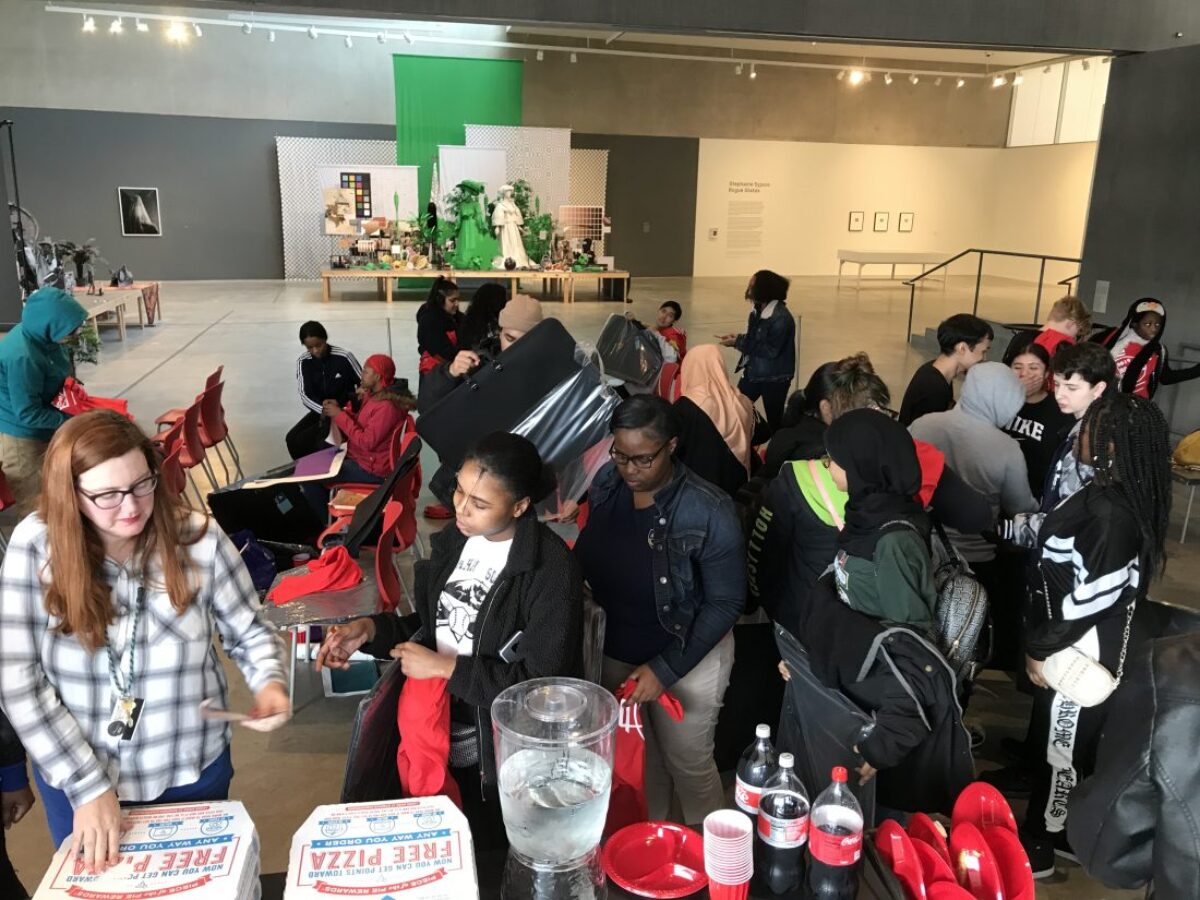“Do more of this,” Amanda Bowles says. She points at a small drawing in Alyssa Hesser’s sketchbook: Alyssa, a student at Central Visual and Performing Arts High School; Amanda, a co-founder of Monaco gallery in St. Louis, an artist with New York exhibitions to her credit, and one of the arts professionals giving critiques to local high school artists on AP Portfolio Day at CAM.
“Do more of this” is one of the simplest yet most impactful directives a young artist can hear: this is a trail to follow; follow it. I remember an art professor from my university days who would say to any student who suddenly made a breakthrough: “That’s great. Now do it a hundred times.”
In Alyssa’s sketchbook, amidst pages of pencil-drawn characters, any of whom could stand in for Marvel heroes: a small realistic drawing of a bandaged hand, Alyssa’s hand, with an IV stuck in it.
Amanda asks if drawing the bandaged hand actually eased the hurt in that hand. Yes, it did. Amanda notes the technical ability evident in the drawing: “I can see this is a bandage. I can tell this is a hospital setting. Anyone who’s had an IV recognizes that it hurts.” There are so many qualities the drawing opens ups: “a hand can be as expressive as a face; it’s a small drawing that has a lot of emotion.”
Unfortunately the time is up. Amanda had tried to squeeze in Alyssa for just one more individual critique, but now the young artists are being called to assemble for a presentation in CAM’s performance space. Alyssa takes her sketchbook and the directive “do more,” and heads downstairs to join 38 students and their teachers from seven local schools, many of whom arrived by buses early this morning.
For CAM’s AP Portfolio Day, Amanda tells me on an upstairs sofa, she’s seen mostly 2-D work, drawing and painting mixed, very little observation drawing, “not from life, but invented worlds.”
“This is my favorite thing,” Amanda affirms. “I love the students. I believe in the art process. Meeting young artists at this moment—14 to 17—they are so amorphous at this time of their lives. You can really make an impact on them.” I mention the do-it-a-hundred-times edict. “Reiteration is so important,” she confirms. “The power of critical thinking is so important for them at this time, when they’re in the middle of their adolescent brain development. This is the best time to introduce them to critical thinking power.
“And it matters that it’s happening here at CAM,” she adds. “I become an extension of this institution. They take a bus to visit an alternative universe. This gives me the opportunity to validate. I can see threads of what they may be in ten years. This is a really cool thing. I only have a few minutes with these young artists, but if you can establish a connection in that moment, it’s like a little arrow.”
Amanda talks more about Alyssa’s drawing of her bandaged hand: “She’s drawing in the hospital as it happened. Her response was to see her hand so beautifully; she saw the idiosyncracies of her own hand. Nothing in life is regular, and she sees the cramped quality of two fingers closed together. This was her moment of her really seeing. Looking! That’s the thing.”
Amanda is done for the day after a long morning of critiques. I find Alyssa in CAM’s café eating pizza with a friend. I ask her about her experience in her too-brief critique with Amanda. “It was very nice to hear what someone—at first glance—saw in my art.” And what will she do with that? “First I have to finish it, and then probably do more like it.” She pauses. “Art that conveys emotion.” The phrase lingers. “It was probably an accident this time,” I suggest. Alyssa laughs. “Yeah. This time it was.”
To learn more about AP Portfolio Day and other ArtReach programs, go here.
—Eddie Silva
